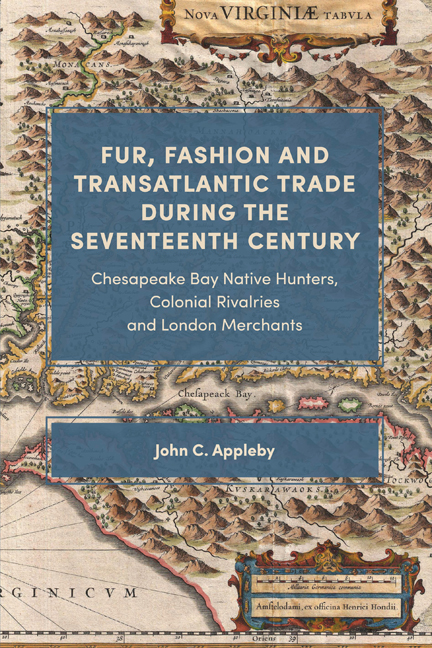 Fur, Fashion and Transatlantic Trade during the Seventeenth Century
Fur, Fashion and Transatlantic Trade during the Seventeenth Century Book contents
- Frontmatter
- Contents
- Acknowledgements
- A Note on Conventions
- Abbreviations
- Maps
- Introduction
- 1 Fur and Fashion: The Infrastructure of a New Trade
- 2 Commerce and Colonization: The Emergence of the Fur Trade in Chesapeake Bay
- 3 Trade and Rivalry: The Promise of Expansion and Innovation during the 1630s
- 4 Trade, Rivalry and Conflict during a ‘Time of Troubles’ from 1640 to 1660
- 5 Commercial Change and Conflict: Contrasting Experiences after 1650
- 6 Trade, Consumption and Industry: Transatlantic Constraints on the Bay Trade
- Conclusion
- Appendix
- Select Bibliography of Works Consulted
- Index
Conclusion
Published online by Cambridge University Press: 15 December 2020
- Frontmatter
- Contents
- Acknowledgements
- A Note on Conventions
- Abbreviations
- Maps
- Introduction
- 1 Fur and Fashion: The Infrastructure of a New Trade
- 2 Commerce and Colonization: The Emergence of the Fur Trade in Chesapeake Bay
- 3 Trade and Rivalry: The Promise of Expansion and Innovation during the 1630s
- 4 Trade, Rivalry and Conflict during a ‘Time of Troubles’ from 1640 to 1660
- 5 Commercial Change and Conflict: Contrasting Experiences after 1650
- 6 Trade, Consumption and Industry: Transatlantic Constraints on the Bay Trade
- Conclusion
- Appendix
- Select Bibliography of Works Consulted
- Index
Summary
In The Planter's Speech of 1684 Thomas Tryon provided a voice for the complaints of mute animals against the oppression and violence they suffered at the hands of English colonists in North America. With the recentlyestablished Quaker settlement of Pennsylvania in his sights, he mocked the absurdity of ‘those who fly from Violence in one place’, to inflict it on the ‘Innocent in those places where they take shelter’. It seemed as if the settlers had declared war against the wildlife of their new habitations. With the advantage of muskets and snares, they were more efficient at killing animals than the natives, who hunted only for food and necessity. But even among the Indians, intensive hunting and destruction had become both ‘an Occupation and a Trade’. Through the acquisition of guns, they grew ‘more expert in all kind of Violence’, travelling ‘night & day with all Pains and Cunning imaginable, to hunt … Creatures, not so much now for Food, as for the Skins, Feathers or Carkasses to sell’. Contracting diseases ‘never before heard amongst them’, they ‘put themselves to a World of needless Slavery and Toil’. More than a century later Thomas Jefferson claimed, in his influential Notes on the State of Virginia, that the ‘general destruction’ of North American game by the Indians began with their trading relations with Europeans, ‘for the purpose of purchasing matchcoats, hatchets, and fire locks, with their skins’.
These insights have been echoed by modern scholarship on the fur trade. It is widely recognized that the beaver was the victim of an unparalleled and devastating hunt. The consequences were evident along some parts of the eastern seaboard by the mid-seventeenth century, in the depletion or disappearance of local populations of fur-bearing animals. During this early period of interethnic commercial activity, exports of beaver skins from Canada to France may have reached a high point of about 30,000, while later annual shipments from New Netherland were even greater. By comparison, the volume of trade from English colonies in the Chesapeake was much less, amounting to between 2,500 and 3,000 skins in some years, though exports were higher for New England.
- Type
- Chapter
- Information
- Fur, Fashion and Transatlantic Trade during the Seventeenth CenturyChesapeake Bay Native Hunters, Colonial Rivalries and London Merchants, pp. 241 - 252Publisher: Boydell & BrewerPrint publication year: 2021


